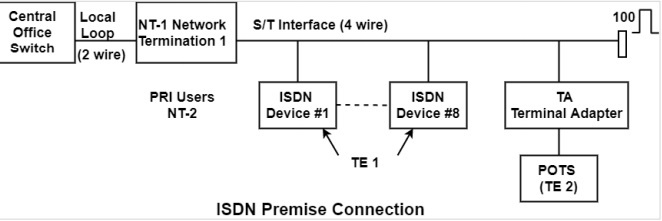
 Data Structure
Data Structure Networking
Networking RDBMS
RDBMS Operating System
Operating System Java
Java MS Excel
MS Excel iOS
iOS HTML
HTML CSS
CSS Android
Android Python
Python C Programming
C Programming C++
C++ C#
C# MongoDB
MongoDB MySQL
MySQL Javascript
Javascript PHP
PHP
- Selected Reading
- UPSC IAS Exams Notes
- Developer's Best Practices
- Questions and Answers
- Effective Resume Writing
- HR Interview Questions
- Computer Glossary
- Who is Who
Explain the ISDN services and its structure.
There are two essential Integrated Services Digital Network (ISDN) services offered in computer network, which are as follows −
Basic Rate Interface (BRI)
It consists of 2B + D channels which stand for 2 Bearer medium of 64 kbps each for data and one D channel of 16 Kbps for handshaking and control. It can have a separate track for handshaking and control is known as 'out of band' signaling.
Primary Rate Interface (PRI)
It consists of 23B + D channels that stand for 23 Bearer medium of 64 kbps each for data and one D medium of 64 Kbps for handshaking control. The Bearer channels can be secured in any merger as needed.
ISDN lines are used to dedicated lines that are continually up and linked or dialed on demand (DOD) lines. When the line is needed, the connection is dialed up and created. The connection time for an ISDN channel is rapid, of the order of 0.5 seconds.
ISDN Structure
The ISDN structure is explained below−
| OSI Model | ISDN | |
| Network | DC Channel | |
| Data Link | B Channel | |
| Physical |
ISDN and OSI Model
The D channel facilitates the OSI Network layer while the B channel uses both the Data Link and Physical Layer. ISDN uses the line encoding in standard telecommunication 2B1Q, which stands for 2 Binary elements encoded in 1 quaternary. A dibit (digital bit) represents two binary elements for each voltage change.
The following table shows the 2B1Q encoding used by ISDN −
| Dibit | Voltage |
|---|---|
| 10 | +3 |
| 11 | +1 |
| 01 | -1 |
| 00 | -3 |
ISDN Premise Connection
The following diagram illustrates a basis ISDN connection from the Central Office to the premise:

The Central Office should have ISDN capabilities in the switch to connect to an ISDN premise. The connection from the Central Office to the premise uses the existing analog phone lines.
At the basic rate interface (BRI) argument, a Network Termination 1 (NT-1) machine converts the 2 wire analog line to a 4 wire system known as the S/T interface. The S/T communication is a bus topology that terminates in a 100W termination. An NT-2 device converts the T interface into an S interface. NT-2 device communicates with terminal equipment.
A sum of 8 ISDN Terminal Equipment 1 (TE) machines can link to the S/T Interface. If access is needed to traditional analog devices such as a plain old telephone set called Terminal Equipment 2 (TE 2) devices, a Terminal Adapter (TA) can provide access.

